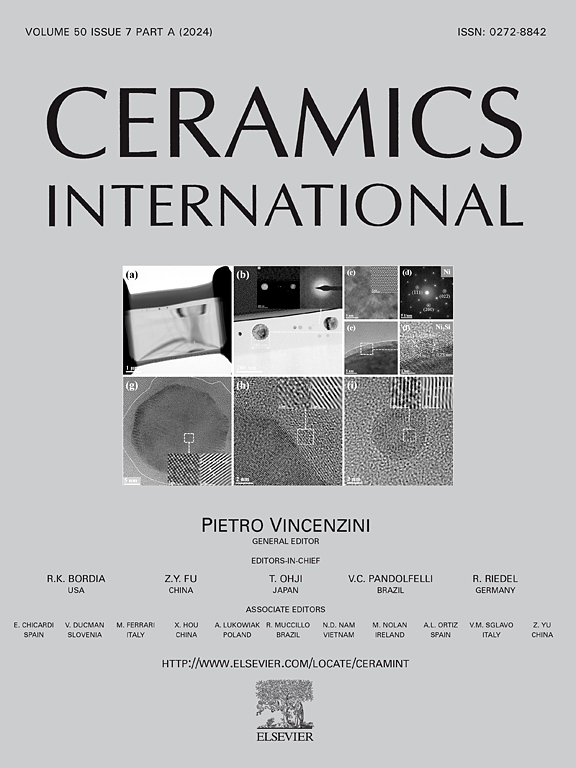HA and Fe-based alloy amorphous composite coating on the surface of degradable magnesium alloy
IF 5.1
2区 材料科学
Q1 MATERIALS SCIENCE, CERAMICS
引用次数: 0
Abstract
HA and Fe-based amorphous composite coatings containing different proportions of hydroxyapatite were prepared on the surface of ZK60A magnesium alloy by high-velocity oxygen-fuel (HVOF) spraying. The microstructure, microhardness, and wettability of the coatings were systematically examined to identify the composite coating with optimal properties. The evolutionary behavior of the corrosion products of each coating at different time stages was analyzed by immersion experiments, and the degradation rate was calculated by counting the mass loss. The degradation rate of the optimal composite coating (0.0468 mm/year) is lower than the degradation rate of the pure Fe-based amorphous coating (0.0936 mm/year). Electrochemical tests and in vitro cell culture experiments indicate that, in simulated body fluid, Fe-based amorphous composite coatings with a certain proportion of HA exhibit better corrosion resistance and biocompatibility compared to Fe-based amorphous coatings. These results provide some insights into the development of Fe-based amorphous composite coatings for potential biomedical applications.
求助全文
约1分钟内获得全文
求助全文
来源期刊

Ceramics International
工程技术-材料科学:硅酸盐
CiteScore
9.40
自引率
15.40%
发文量
4558
审稿时长
25 days
期刊介绍:
Ceramics International covers the science of advanced ceramic materials. The journal encourages contributions that demonstrate how an understanding of the basic chemical and physical phenomena may direct materials design and stimulate ideas for new or improved processing techniques, in order to obtain materials with desired structural features and properties.
Ceramics International covers oxide and non-oxide ceramics, functional glasses, glass ceramics, amorphous inorganic non-metallic materials (and their combinations with metal and organic materials), in the form of particulates, dense or porous bodies, thin/thick films and laminated, graded and composite structures. Process related topics such as ceramic-ceramic joints or joining ceramics with dissimilar materials, as well as surface finishing and conditioning are also covered. Besides traditional processing techniques, manufacturing routes of interest include innovative procedures benefiting from externally applied stresses, electromagnetic fields and energetic beams, as well as top-down and self-assembly nanotechnology approaches. In addition, the journal welcomes submissions on bio-inspired and bio-enabled materials designs, experimentally validated multi scale modelling and simulation for materials design, and the use of the most advanced chemical and physical characterization techniques of structure, properties and behaviour.
Technologically relevant low-dimensional systems are a particular focus of Ceramics International. These include 0, 1 and 2-D nanomaterials (also covering CNTs, graphene and related materials, and diamond-like carbons), their nanocomposites, as well as nano-hybrids and hierarchical multifunctional nanostructures that might integrate molecular, biological and electronic components.
 求助内容:
求助内容: 应助结果提醒方式:
应助结果提醒方式:


